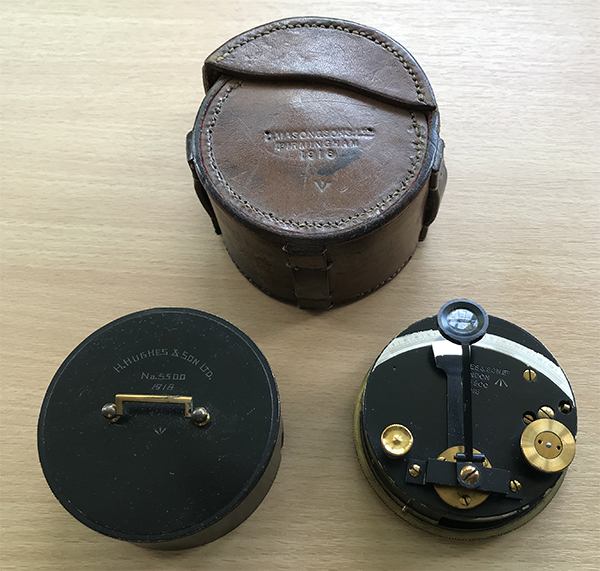
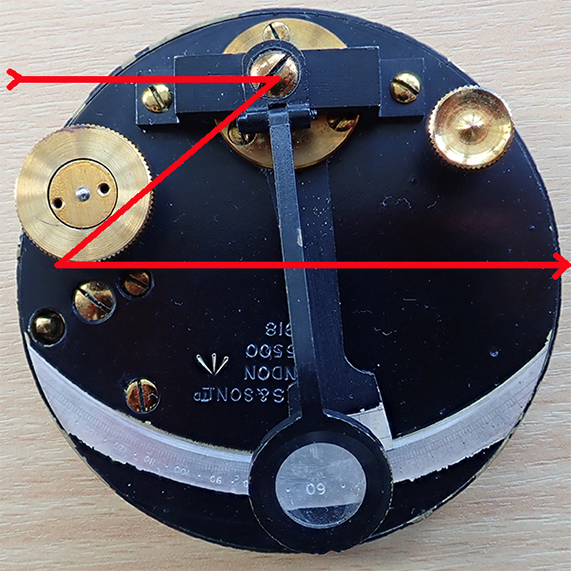
|
'Brass and glass' part 2 - box sextant. by David Walker, items discussed being co-owned with Ian Walker, UK |
'Brass and glass' in the context of this site is usually associated with the many makers and models of pre-20th century microscopes where the finish was typically lacquered brass. My brother Ian and I over the years have been custodians of a variety and have often shared our experiences of them. A limited budget and space has always kept this collection to three or four at most. We enjoy using and researching their history and after a few years, resell to release the budget for new explorations.
We pride ourselves on always passing them on in better condition than when acquired. We have lost count of examples that from their state seemed to have been passed through a cycle of owner and/or dealer with no attempt to bring to working condition (this also applies to old slides where it seems to be the norm—dirty and forgotten).
Another of our joint interests is the many aspects of the history of exploration, navigation and timekeeping—whether old maps, atlases, reading the exploits of explorers etc. In my case I have a particular interest in the quest for the North West Passage. As a new avenue for a collection of 'brass and glass' over the past few years we have bought where affordable examples associated with these interests to enjoy and research. In last month's article we shared our two pocket sundials, in this part two our box sextant is discussed and illustrated. In part three our three full sized sextants will be shared.
Pocket sextant 'H. Hughes & Sons Ltd. No. 5500. 1918' 71 mm diameter, 38 mm high. Leather case inscribed 'D. Mason & Sons Ltd. Birmingham. 1918. Broad arrow on item and case.
The first thing that is striking when handling is how reassuringly heavy it is for its size (393g) being fashioned entirely from brass. As it is closely inspected the standard of workmanship is very apparent, even the handle is delicately figured. The maker was one of the leading British firms making sextants.
Box sextants were not pocket novelty items, they were serious instruments designed for use when portability was key for surveying or celestial observations. The index arm radius is ca. 44 mm which contrasts with the typical full sized sextant's index arm of radius 6.5 to 8 inches (165 - 203 mm). The scale is likely silver and inscribed to 30 minutes, the 30 division vernier allowing readings to 1'. Full sized sextants typically have inscribed scales with vernier or micrometer to read to ca. 5-10". The broad arrow on case and sextant is found on certain British government or army issued items.
The Smithsonian website describes a selection. They note this form was introduced in 1797 by the London maker William Jones. Uses noted include for military reconnaissance and our own example with its broad arrow markings may have been for this purpose. The Nautical Sextant website of W. J. Morris who wrote a splendid book with this title has a page devoted to the box sextant and shows an example disassembled. Our own example has tiny likely seized old screws which was reluctant to undo.
The case is in excellent condition and still supple for its age. At first, thought D. Mason & Sons Ltd. may have been the dealer who sold the sextant but a Google search reveals they were makers of leather goods. Full sized sextants often had an option for a large telescope to be fitted with exit pupils (objective diameter / eyepiece mag) of five or more—a value that birdwatchers / astronomers would be impressed with for their light gathering capability. On this box sextant the viewing aperture with lens is tiny but surprising how bright it is, even indoors. Some box sextants came supplied with an external telescope that attached on to the unit. There are recessed filters both for the index mirror which reflects the celestial object and for the horizon mirror. These filters are activated by recessed controls as shown below.


The box sextant is finely engineered. The principle and layout is essentially a miniature version of a full sized example using the principle of double reflection proposed by Newton (part three will expand a little on the sextant and its development from earlier methods of measuring altitudes).
Image right: The light path is shown in red. The lens folds down for storage and height adjusted for scale focus. The index mirror which reflects the object of study is on the axis of the index arm. Its angle is adjusted with the knob left. This image is reflected to the horizon mirror at the acute angle shown and sent to the eyepiece. The smaller knob right unscrews entirely as it is a tool
to adjust the small recessed square peg for the horizon mirror far left.

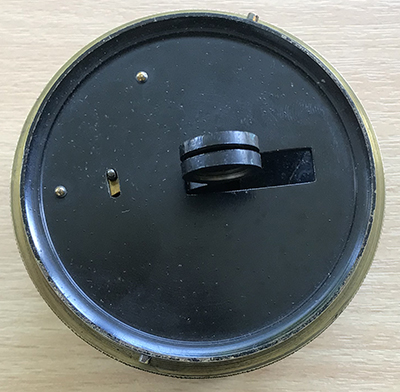
A dust cover is swung aside using recessed knob to allow the two index mirror filters to be taken out of the optical path for less bright objects.
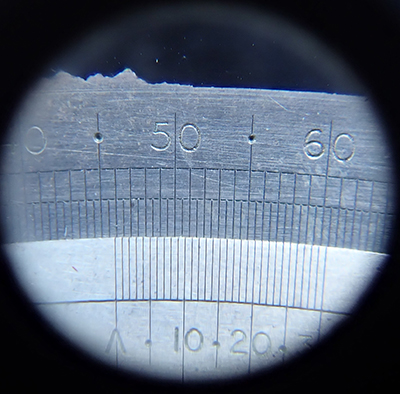
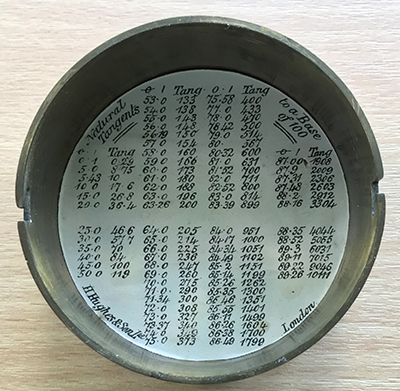
The scale is inscribed to 30' with a 30 division vernier allowing readings to 1'. A full sized sextant can typically read to 5- 10".
The lid has tangent tables to base 100. The sharp eyed may wonder of the inclusion of tangent values which were whole numbers to base 100. The Appendix elaborates on this.
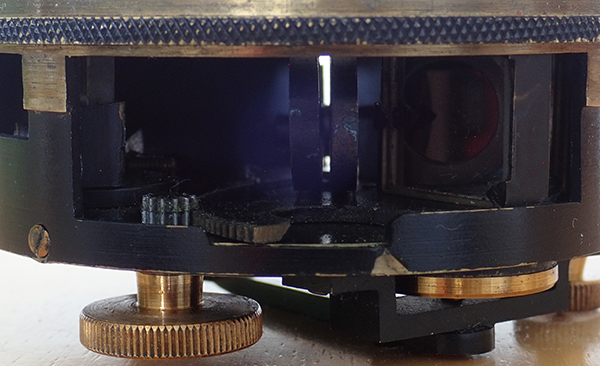
The two viewing aperture filters (centre) are recessed and in the optical path of the index mirror as shown.
The knob and gearing to adjust the angle of the index mirror to read the altitude is shown left. The index mirror is on the right.

The tiny viewing aperture is at centre. The recessed sliding knob left swings across a filter over this aperture if required for sun sights.
The levers right raise and lower the two filters for the index mirror, the one that reflects a celestial object.
Comments to the author David Walker are welcomed.
Safety note. It is unwise to use an old sextant for sun sightings. The filters may have deteriorated and not to modern safety standards. The authors do not use their sextants at all for sun sightings partly because of this but also unfamilar with safe sextant practice where must never accidentally point the sighting telescope at the sun rather than the horizon. Moon sights during the day if well away from the sun or at night would be safer.
Appendix - The tangents table
Box sextants typically had a table of tangents in the lid as shown above. In addition to providing values for even increments of degrees, additional values are given including for angles where the tangents are whole values to base 100. Intrigued by this, some deep diving on the archive.org site into 19th century books on military topography provided an insight.
The box sextant could be used for traditional celestial navigation and the altitude read off but they were also used for example in army reconnaissance. The 'Textbook of Military Topography' by Col. W. H. Richards, 1883 illustrates the use of a box sextant to measure the distance across a river.
At starting point a right angle is created using sextant at 90 degrees to fix a point across the river and a point this side to walk towards. Then walk along bank until the point across river reflects on to starting point but at a distance where the angle is a convenient multiplier (above 45 deg) or divisor (below 45 deg.) value as in the table. Other examples include measuring the height of an object.
The odd low and high angle values are included presumably for divisor / multiplier values appropriate for the distances being measured.
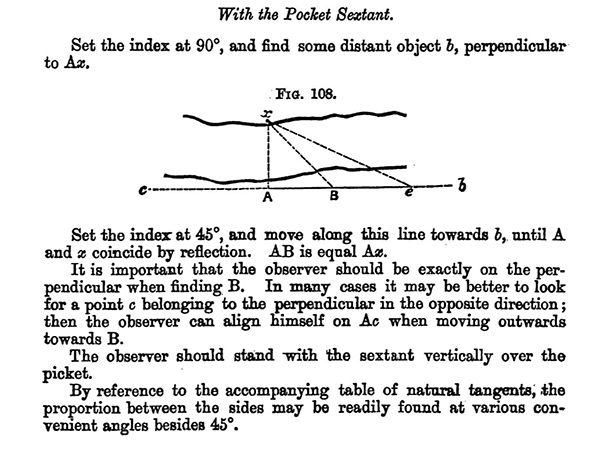
Published in the July 2023 edition of Micscape.
Please report any Web problems or offer general comments to the Micscape Editor .
Micscape is the on-line monthly magazine of the Microscopy UK web site at Microscopy-UK
©
Onview.net Ltd, Microscopy-UK, and all contributors 1995
onwards. All rights reserved.
Main site is at www.microscopy-uk.org.uk.